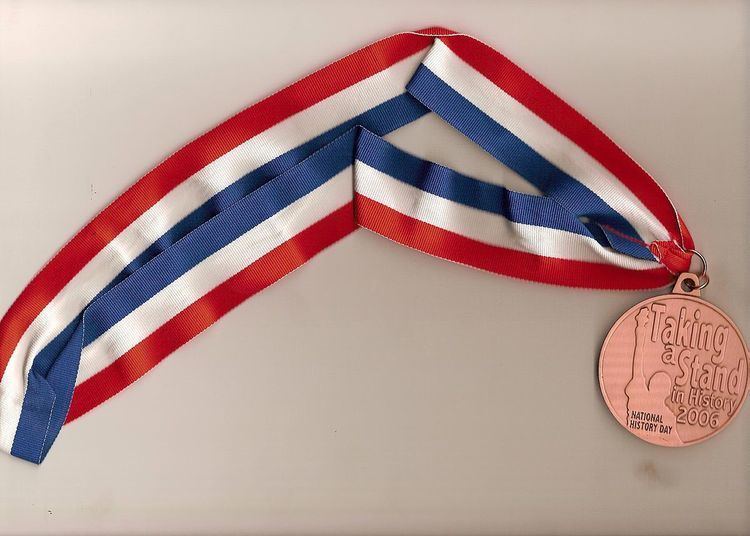Abbreviation NHD Type Nonprofit Organization | Formation 1974 Legal status Active | |
 | ||
Motto It's more than a day, it's an Experience. Purpose To promote the study and appreciation of history among students. | ||
National History Day is non-profit organization based in College Park, Maryland that operates an annual project-based contest for students in grades 6-12. It has affiliates in all fifty states, Washington, D.C., Puerto Rico, Guam, American Samoa, South Korea, China, South Asia, and Central America. It started as a local program in Cleveland, Ohio, headed by Dr. David Van Tassell, a history professor at Case Western Reserve University. It grew from 129 students in 1974 to over 500,000 students in 48 states in 1991, and 700,000 students and 40,000 teachers in 2001. Today more than half a million students enter through local contests. They construct entries as an individual or a group in one of five categories: Documentary, Exhibit, Paper, Performance or Website. Students then compete in a series of regional contests with top entries advancing to state/affiliate contests. The top two entries in each category and division are invited to compete at the National Contest.
Contents
History of the National History Day Contest
The contest started in Cleveland in 1974. Members of the History Department at Case Western Reserve University developed the initial idea for a history contest akin to Science Fair. Students gathered on campus to devote one day to history calling it "National History Day." Over the next few years, the contest expanded throughout Ohio and into surrounding Midwestern states. By 1980, with the help of the National Endowment for the Humanities, National History Day had grown into a national non-profit organization and in 1992 National History Day moved its headquarters from Cleveland to the Washington, D.C., area. National History Day now runs multiple educational programs but the National Contest is still the largest of these. The national finals take place each June during a week-long event held at the University of Maryland, College Park.
National History Day Contest Annual Theme
The annual theme is usually a phrase ending with "in history" and is often an alliteration, such as, "Revolution, Reaction, Reform in History." The theme frames students’ research within a historical theme. The theme is chosen for the broad application to world, national, or state history and its relevance to ancient history or to the more recent past. The 2017 theme is Taking a Stand in History. "The intentional selection of the theme for the National History Day Contest is to provide an opportunity for students to push past the antiquated view of history as mere facts and dates and drill down into historical content to develop perspective and understanding." Themes are rotated each year and prior themes are often used after approximately seven years.
Judging
National History Day participants are judged on three deciding factors: Historical Quality, Relation to Theme, and Clarity of Presentation. Research should include primary and secondart sources. Additionally, sources need to be clearly cited with the inclusion of an annotated bibliography.
State and Regional Competitions
In some regions, students who reach enough points in their judging advance to states, and any amount of students at regional competitions can advance to states. In other states, such as California, Connecticut, and Pennsylvania, the top three projects at the regional competition advance to the state competition. Regions can be divided by geographic area, population, or by county.
At the state/affiliate level contests, students compete for a variety of prizes. The top two entries in each category and division are invited to the National Contest held each June at the University of Maryland, College Park.
Preliminaries
In the preliminary rounds, each entry presents their project before a panel of three judges. In the case of the paper and website categories, the projects have been reviewed by the judges prior to the presentations. Performances, documentaries, and exhibits are presented for the judges for the first time at the contest. The top entry in each judging group advances to the final round, called "Run Offs."
Finals
Those in the performance and documentary categories are notified they advanced to the final round and then present their work to a panel of three new judges. Those in the paper, website, and exhibit categories are not informed if they have made it into the final round. Their projects are judged by a panel of three new judges, but the students are not interviewed in this round. Their project then has to stand alone for the final judging.
The awards for first, second, and third place at the national level are $1000, $500, and $250, respectively. "Outstanding Entry" awards are also given to two projects from each state: one junior entry and one senior entry. There are also more than a dozen special prizes awarded worth between $500 and $1,000.
Impact on students
An independent study conducted in 2011 demonstrated that students who participate in the National History Day Contest outperform their non-participating peers and score higher on standardized tests.
Impact on historians
Arnita Jones, executive director of the American Historical Association, wrote in 2001:
Perhaps the greatest impact of National History Day...was on the historical profession itself. I truly believe that never have so many historians enjoyed engaging in the pursuit of history outside their offices, their regular classrooms, and their academic research as have the thousands who have participated in National History Day as teachers, mentors, consultants and judges over more than two decades.